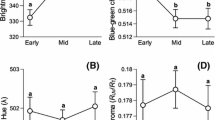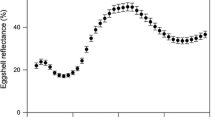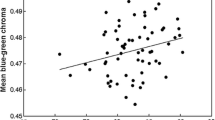Abstract
The striking diversity of avian eggshell colour has long fascinated biologists. Recently, it has been proposed that the blue-green colour of some eggs may function as a post-mating sexually selected signal of female phenotypic quality to their mates to induce higher allocation of paternal care. It has been suggested that maternally deposited yolk carotenoids may be the specific aspect of reproductive quality that the female is signalling via eggshell colour. We use the known properties of the thrush visual system (Turdus sp.) to calculate photon capture for the four single cone photoreceptors, and the principal member of the double cone class for eggs in clutches of two introduced European thrush species (Turdus merula and Turdus philomelos) in New Zealand. We show that differences in the avian-perceived colours of individual eggs are not consistently correlated with different measures of maternal investment in the egg. Given the growing extent of the knowledge between maternal quality, parental investment and eggshell pigmentation across avian taxa, we encourage the use of avian perceptual modelling for testing alternative non-signalling explanations for the structural and physiological basis of these relationships.


Similar content being viewed by others
References
Akaike H (1974) A new look at the statistical model identification. IEEE Trans Automat Contr 19:716–723
Aviles JM, Stokke BG, Moksnes A (2007) Environmental conditions influence egg color of reed warblers Acrocephalus scirpaceus and their parasite, the common cuckoo Cuculus canorus. Behav Ecol Sociobiol 61:475–485
Bakken GS, Vanderbilt VC, Buttemer WA, Dawson WR (1978) Avian eggs: thermoregulatory value of very high near-infrared reflectance. Science 200:321–323
Bennett ATD, Théry M (2007) Avian color vision and coloration: multidisciplinary evolutionary biology. Am Nat 169:S1–S6
Biard C, Surai PF, Moller AP (2005) Effects of carotenoid availability during laying on reproduction in the blue tit. Oecologia 144:32–44
Blount JD, Houston DC, Moller AP (2000) Why egg yolk is yellow. Trends Ecol Evol 15:47–49
Burnham KP, Anderson DR (2002) Model selection and multimodel inference: a practice information-theoretic approach. Springer, Berlin Heidelberg New York
Cassey P, Ewen JG, Boulton RL, Blackburn TM, Moller AP, Biard C, Olson V, Karadas F (2005) Egg carotenoids in passerine birds introduced to New Zealand: relations to ecological factors, integument coloration and phylogeny. Funct Ecol 19:719–726
Cassey P, Blackburn TM, Evans KL (2006a) Changes in egg size of exotic passerines introduced to New Zealand. Notornis 52:243–246
Cassey P, Ewen JG, Karadas F, Hauber ME (2006b) Repeatability of laboratory measurements for maternally derived yolk carotenoid concentrations in bird eggs. Aust J Zool 54:381–384
Cherry MI, Bennett ATD (2001) Egg colour matching in an African cuckoo, as revealed by ultraviolet-visible reflectance spectrophotometry. Proc R Soc Lond B 268:565–571
Cherry MI, Bennett ATD, Moskát C (2007) Host intra-clutch variation, cuckoo egg matching and egg rejection by great reed warblers. Naturwissenschaften 94:441–447
del Hoyo J, Elliott A, Christie DA (2006) Handbook of the birds of the world: cuckoo-shrikes to thrushes, vol. 10. Lynx, Barcelona
Endler JA (1993) The color of light in forests and its implications. Ecol Appl 63:1–27
Endler JA, Mielke PW (2005) Comparing entire colour patterns as birds see them. Biol J Linn Soc 86:405–431
Falchuk KH, Contin JM, Dziedzic TS, Feng ZL, French TC, Heffron GJ, Montorzi M (2002) A role for biliverdin IX alpha in dorsal axis development of Xenopus laevis embryos. PNAS 99:251–256
Goldsmith TH, Butler BK (2005) Color vision of the bugerigar (Melopsittacus undulatus): hue matches, tetrachromacy, and intensity discrimination. J Comp Physiol A 191:933–951
Gosler AG, Higham JP, Reynolds SJ (2005) Why are birds’ eggs speckled. Ecol Lett 8:1105–1113
Götmark F (1992) Blue eggs do not reduce nest predation in the song thrush, Turdus philomelos. Behav Ecol Sociobiol 30:245–252
Grim T, Honza M (2001) Differences in behaviour of closely related thrushes (Turdus philomelos and T. merula) to experimental parasitism by the common cuckoo Cuculus canorus. Biologia 56:549–556
Hargitai R, Matus Z, Hegyi G, Michl G, Toth G, Torok J (2006) Amtioxidants in the egg yolk of a wild passerine: differences between breeding seasons. Comp Biochem Physiol, B Biochem Mol Biol 143:145–152
Hart NS (2001) The visual ecology of avian photoreceptors. Prog Retin Eye Res 20:675–703
Hart NS, Partridge JC, Cuthill IC (1998) Visual pigments, oil droplets and cone photoreceptor distribution in the European starling (Sturnus vulgaris). J Exp Biol 201:1433–1446
Hart NS, Partridge JC, Cuthill IC, Bennett ATD (2000) Visual pigments, oil droplets, ocular media and cone photoreceptor distribution in two species of passerine bird: the blue tit (Parus caeruleus L.) and the blackbird (Turdus merula L.). J Comp Physiol, A 186:375–387
Hettmansperger TP, Randles RH (2002) A practical affine equivariant multivariate median. Biometrika 89:851–860
Higham JP, Gosler AG (2006) Speckled eggs: water-loss and incubation behaviour in the great tit Parus major. Oecologia 149:561–570
Honza M, Kuiper SM, Cherry MI (2005) Behaviour of African turdid host towards experimental parasitism with artificial red-chested cuckoo Cuculus solitarius eggs. J Avian Biol 36:517–522
Honza M, Polaciková L, Procházka P (2007) Ultraviolet and green parts of the colour spectrum affect egg rejection in the song thrush (Turdus philomelos). Biol J Linn Soc 92:000–000
Kelber A, Vorobyev M, Osorio D (2003) Animal colour vision—behavioural tests and physiological concepts. Biol Rev 78:81–118
Kilner RM (2006) The evolution of egg colour and patterning in birds. Biol Rev 81:383–406
Krist M, Grim T (2007) Are blue eggs a sexually selected signal of female collared flycatchers? A cross-fostering experiment. Behav Ecol Sociobiol 61:863–876
Lack D (1958) The significance of the colour of turdinae eggs. Ibis 100:145–166
Lessells CM, Boag PT (1987) Unrepeatable repeatabilities: a common mistake. Auk 104:116–121
Lyon BE (2007) Mechanism of egg recognition in defenses against conspecific brood parasitism: American coots (Fulica americana) know their own eggs. Behav Ecol Sociob 61:455–463
Maier EJ, Bowmaker JK (1993) Colour vision in the passeriform bird, Leiothrix lutea: correlation of visual pigment absorbency and oil droplet transmission with spectral sensitivity. J Comp Physiol, A Sens Neural Behav Physiol 172:295–301
Martinez-de la Puente J, Merino S, Moreno J, Tomas G, Morales J, Lobato E, Garcia-Fraile S, Martinez J (2007) Are eggshell spottiness and colour indicators of health and condition in blue tits Cyanistes caeruleus. J Avian Biol 38:377–384
McGraw KJ, Ardia DR (2003) Carotenoids, immunocompetence, and the information content of sexual colors: an experimental test. Am Nat 162:704–712
McGraw KJ, Adkins-Regan E, Parker RS (2005) Maternally derived carotenoid pigments affect offspring survival, sex ratio, and sexual attractiveness in a colorful songbird. Naturwissenschaften 92:375–380
Morales J, Sanz JJ, Moreno J (2006) Egg colour reflects the amount of yolk maternal antibodies and fledging success in a songbird. Biol Lett 2:334–336
Moreno J, Osorno JL (2003) Avian egg colour and sexual selection: does eggshell pigmentation reflect female condition and genetic quality. Ecol Lett 6:803–806
Moreno J, Osorno JL, Morales J, Merino S, Tomas G (2004) Egg colouration and male parental effort in the pied flycatcher Ficedula hypoleuca. J Avian Biol 35:300–304
Moreno J, Morales J, Lobato E, Merino S, Tomas G, Martinez-de la Puente J (2005) Evidence for the signaling function of egg color in the pied flycatcher Ficedula hypoleuca. Behav Ecol 16:931–937
Moreno J, Lobato E, Morales J, Merino S, Tomas G, Martinez-de la Puente J, Sanz JJ, Mateo R, Soler JJ (2006) Experimental evidence that egg color indicates female condition at laying in a songbird. Behav Ecol 17:651–655
Moskát C, Karcza Z, Csörgo T (2003) Egg rejection in European Blackbirds (Turdus merula): the effect of mimicry. Ornis Fenn 2003:86–91
Nevalainen J, Oja H (2006) SAS/IML macros for a multivariate analysis of variance based on spatial signs. Journal of Statistical Software 16:1–17
Oniki Y (1985) Why robin eggs are blue and birds build nests: statistical tests for Amazonian birds. Ornithological Monographs 36:536–545
Osorio D, Miklosi A, Gonda Z (1999) Visual ecology and perception of coloration patterns by domestic chicks. Evol Ecol 13:673–689
Rothstein SI (1982) Mechanisms of avian egg recognition: which egg parameters elicit responses by rejecter species. Behav Ecol Sociobiol 11:229–239
Saino N, Bertacche V, Ferrari RP, Martinelli R, Moller AP, Stradi R (2002) Carotenoid concentration in barn swallow eggs is influenced by laying order, maternal infection and paternal ornamentation. Proc R Soc Lond, B Biol Sci 269:1729–1733
Siefferman L (2006) Egg coloration and recognition of conspecific brood parasitism in eastern bluebirds. Ethology 112:833–838
Siefferman L, Navara KJ, Hill GE (2006) Egg coloration is correlated with female condition in eastern bluebirds (Sialia sialis). Behav Ecol Sociobiol 59:651–656
Surai PF (2002) Natural Antioxidants in Avian Nutrition and Reproduction. Nottingham University Press, Nottingham
Underwood TJ, Sealy SG (2002) Adaptive significance of egg coloration. In: Deeming DC (ed) Avian Incubation: Behaviour, Environment and Evolution. Oxford University Press, Oxford, pp 280–289
Vorobyev M (2003) Coloured oil droplets enhance colour discrimination. Proc R Soc Lond, B Biol Sci 270:1255–1261
Vorobyev M, Osorio D (1998) Receptor noise as a determinant of colour thresholds. Proc R Soc Lond B 265:351–358
Vorobyev M, Osorio D, Bennett ATD, Marshal NJ, Cuthill IC (1998) Tetrachromacy, oil droplets and bird plumage colours. J Comp Physiol, A Sens Neural Behav Physiol 183:621–633
Vorobyev M, Brandt R, Peitsch D, Laughlin SB, Menzel R (2001) Colour thresholds and receptor noise: behaviour and physiology compared. Vis Res 41:639–653
Wallace AR (1889) Darwinism: An exposition of the theory of natural selection with some of its applications. Macmillan, London
Weidinger K (2001) Does egg colour affect predation rate on open passerine nests. Behav Ecol Sociobiol 49:456–464
Westmoreland D, Kiltie RA (1996) Egg crypsis and clutch survival in three species of blackbirds (Icteridae). Biol J Linn Soc 58:159–172
Whittingham MJ, Stephens PA, Bradbury RB, Freckleton RP (2006) Why do we still use stepwise modelling in ecology and behaviour. J Anim Ecol 75:1182–1189
Acknowledgements
We are extremely grateful to R. Peacock, B. and G. Cassey, K. Mathews, G. and S. Cassey, M. Thompson and D. Armstrong for accommodation and access to private land. Y. Richard, N. MacArthur and R. Boulton assisted in locating naturally occurring nests, and this study would not have been completed without their input. Spectral sensitivities were kindly provided by N. Hart, J. Lockwood, and three anonymous referees provided comments that greatly improved our draft manuscript. Financial support was provided, in part, by the University of Auckland Research Council (to PC and MEH), the Universitas 21 Birmingham Travel Fund (to PC), a Human Frontier Science Program award (to PC and MEH), the New Zealand Marsden Fund (to MEH) and a Royal Society Grant (to JGE).
Author information
Authors and Affiliations
Corresponding author
Rights and permissions
About this article
Cite this article
Cassey, P., Ewen, J.G., Blackburn, T.M. et al. Eggshell colour does not predict measures of maternal investment in eggs of Turdus thrushes. Naturwissenschaften 95, 713–721 (2008). https://doi.org/10.1007/s00114-008-0376-x
Received:
Revised:
Accepted:
Published:
Issue Date:
DOI: https://doi.org/10.1007/s00114-008-0376-x




